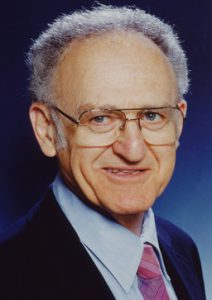Robert “Bob” Plonsey died on March 14, 2015 at the age of 90 in Chapel Hill, NC. Bob will be remembered for his numerous and important contributions to the field of biophysics, particularly the understanding of the origin of biopotentials recorded from heart, muscle and nerve tissue.
 He will also be remembered for his leadership in the establishment of the field of biomedical engineering. He served as president of two of its most important societies, the IEEE Engineering in Medicine and Biology Society (EMBS) from 1973-1974 and the Biomedical Engineering Society from 1981-1982.
He will also be remembered for his leadership in the establishment of the field of biomedical engineering. He served as president of two of its most important societies, the IEEE Engineering in Medicine and Biology Society (EMBS) from 1973-1974 and the Biomedical Engineering Society from 1981-1982.
Bob developed his interest in engineering at Cooper Union School of Engineering in New York, graduating with a degree in electrical engineering in 1943. After serving in the Navy during World War II, he returned to school and obtained the M.E.E degree from New York University in 1948. He then moved to California and enrolled as a PhD student in Electrical Engineering at the University of California, Berkeley where he studied under Sam Silver, an expert in microwave antennas and the theory of diffraction and scattering of electromagnetic waves. Bob’s PhD dissertation was on diffraction by cylindrical reflectors, a topic far removed from the work that would ultimately define his career.
Upon graduation in 1957, Bob became an Assistant Professor of Electrical Engineering at Case Institute of Technology (later to become Case Western Reserve University) in Cleveland, Ohio. It was at Case that Bob began to apply his knowledge of electromagnetism to problems in biophysics, producing seminal work on the extracellular potential of a single active fiber in a volume conductor. He also authored one the first books on this emerging area of study, entitled “Bioelectric Phenomena”. His deep interest for Biomedical Engineering led him to complete the first year and a half of the medical school curriculum at Case Western Reserve University School of Medicine while a faculty member. Bob was one of the founding members of the Bioengineering Group, Systems Research Center, which eventually led to the formation of one of the first Departments of Biomedical Engineering in 1969. He served as its chairman from 1976-1980.
In 1983, Bob moved to Duke University to join the faculty of Biomedical Engineering. At Duke, he collaborated closely with Roger Barr, They were among the first to apply the bidomain model to study propagation of electrical impulses in the heart and proposed the “saw-tooth” mechanism of defibrillation. He and Roger Barr also authored the first textbook on Bioelectricity, Bioelectricity: A Quantitative Approach, which has served to educate numerous undergraduate and graduate students in the discipline of electrobiology. He also coauthored another textbook, “Bioelectromagnetism -Principles and Applications of Bioelectric and Biomagnetic Fields” with Jaakko Malmivuo. Bob retired from Duke in 1996 as the Pfizer Inc./Edmund T. Pratt Jr. University Professor Emeritus of Biomedical Engineering.
Bob received numerous awards and recognitions over his long career. He was elected to the National Academy of Engineering in 1986 for “the application of electromagnetic field theory to biology, and for distinguished leadership in the emerging profession of biomedical engineering.” Among his other honors include Fellow of AAAS, William Morlock Award 1979, Centennial Medal 1984, ALZA distinguished lecturer, 1988 Millenium Medal 2000, from IEEE Engineering in Medicine and Biology Society, Ragnar Granit Prize 2004, International Union for Physiological & Engineering Science in Medicine, Distinguished Service award, Biomedical Engineering Science, 2004 and the Theo Pilkington Outstanding Educator Award, 2005. In 2013, he received the first IEEE Biomedical Engineering Award, “For developing quantitative methods to characterize the electromagnetic fields in excitable tissue, leading to a better understanding of the electrophysiology of nerve, muscle, and brain.”
After retirement, Bob and Vivian, his wife of 62 years, remained very active, spending time with their son Daniel, his wife Mantra, and their two grandsons, Cleveland and Mischa, and travelling to see their many friends and colleagues throughout the world. Bob continued to publish and give lectures, promoting biomedical engineering across the globe. Bob was the epitome of a gentleman and a scholar, and he will be missed by all that were fortunate to know him.
Login to IEEE EMBS
Reset Password
Enter the username or e-mail you used in your profile. A password reset link will be sent to you by email.




